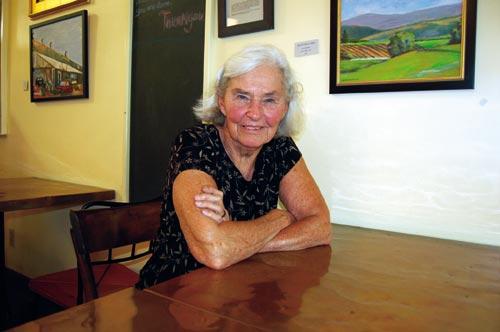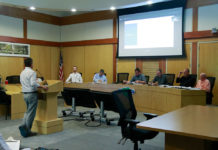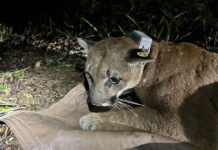Celebrating one’s 80th birthday is a milestone for most. Gail
Roper saw hers as an opportunity to rewrite the record books.
The former Olympian and pioneer in women’s swimming became the
first 80-year-old woman to swim the 100-meter butterfly in less
than 2 minutes at the Huntsman Senior Games in Utah on Oct. 13. The
world record was her tenth of the past year and 103rd in her
career.
That’s right, 103 world records.
News of her accomplishment found its way to the Tribune office
when a woman stopped in with an internet printout in hand
announcing the latest world record. “She’s from Healdsburg,” the
woman said. “You should put this in the newspaper.”
The phone book listed one G Roper living in Healdsburg and a
phone call later she was explaining the story began not with a
world record this month but in 1948 in a high school pool back in
Jersey. Or, as Roper puts it, in the dark ages of women’s
swimming.
This was a time before the NCAA acknowledged women’s swimming as
a sport and long before American Amanda Beard was winning medals in
the Atlanta Summer Games at the age of 14. These were days when
teachers pleaded with girls not to exert themselves in the pool and
when the nylon bathing suits were baggy and included a skirt.
“They didn’t even let girls swim laps in those days,” she said.
“They said it was bad for our hearts. They said our ovaries would
burst and that we’d never have children.”
Instead, the girls swam slowly and judges awarded scores based
on how they looked. “We’d swim one lap and they’d hold up
scorecards and we’d see how many points we’d got from our form,”
she said.
Perceived dangerous or not, Roper loved to swim. And she loved
to win.
After she graduated high school she got her chance to race in a
meet run by the Amateur Athletic Union—better known as AAU—and took
fourth place, missing the winner’s podium by one. “They gave medals
to the first three places,” she said. “That didn’t sit very well
with me. My friend got first place and she wore that medal to
school for three days. I wanted a medal. It was a little jealousy,
but a lot of fun.”
Roper read books on swimming and trained on her own and it
wasn’t long until she climbed up on that podium. “I took third
place, and after I got third I thought, ‘gee, maybe I can get first
place.’”
She didn’t stop there. Roper was the New Jersey State Champion
in 1948-1951 and the national champion in the 100-yard and 200-yard
breaststroke and the 300-yard medley in 1952. That year she
appeared in Life Magazine after winning at nationals and, on July
4, won the 200-meter breaststroke at the Olympic Trials.
In four years the girl from Jersey had swam her way from the
Delaware River to the Olympic Games in Helsinki, Finland.
The 1952 Summer Games welcomed the U.S.S.R. and Israel to
Olympic Competition for the first time, and welcomed back Germany
and Japan after both countries served bans in 1948 following World
War II. Women only had five swimming events back then, including
the 100-meter free, 100-meter backstroke, 200-meter breaststroke,
400-meter free and a relay.
Only 100 miles from the arctic, Helsinki was cold even in July.
“It was 41 degrees outside, and the water was 71 degrees,” she
said. “Everyone sitting in the stands wore coats. I was all of 109
pounds and was shaking uncontrollably.”
Roper pulled a ligament in her ankle but swam anyway even after
she was warned she might damage herself permanently. She did not do
well and returned to the United States, crushed. “I was so
depressed because I had missed my chance,” she said. “Everyone
tried to discourage me when I said I would try to go back in four
years. They said I was being greedy and that I already had my
chance and if I tried again I’d be taking away someone else’s
chance to make the Olympic team.”
She moved to Hawaii and returned to the pool, racing with a team
of talented girls with Olympic dreams. When the girls headed off to
trials Roper stayed home. “My coach said I was too old,” she
said.
And so, Roper did what she had always refused to do before. “I
stopped,” she said.
Roper got married, had seven children—including six
daughters—and quit swimming for 20 years. She gave her girls every
opportunity to swim that she did not have growing up. Daughter
Sarah Quider said she and her sisters didn’t always appreciate it.
“I remember hiding underneath the bed because of swimming
practice,” she said with a laugh.
Roper’s retirement came to an end in 1970 when she joined the
recently formed United States Masters Swimming program. Her return
to national dominance came quickly. She set records in all four
strokes and the individual medley in the 45-49 age group.
Every five years gave Roper new age-group records to set, and
she took full advantage. In 1997 she was inducted to the
International Swimming Hall of Fame and has only added to her
legacy in the decade since.
Nancy Wright of Masters Swimming calls Roper—and all the other
women who persevered through the dark ages of swimming—pioneers.
“They persisted with no rewards other than personal satisfaction
and, maybe, a medal,” she said. “They weren’t swimming for
lucrative endorsements and contracts, there were no college
scholarships. It was a labor of love.”
Roper moved to Healdsburg 10 years ago to train at the city pool
and is now a regular at Downtown Bakery. She still works full-time
for the federal government and swims three mornings a week.
“She’s unbelievable,” said Quider. “You can say she’s
competitive, but you could also say she’s determined and just loves
swimming. Her best days are in the water. She enjoys it with a
passion.”









